What is the International Phonetic Alphabet?
In a previous blog, I talked about the International Phonetic Alphabet (IPA) and why it is such a valuable tool when learning a new language. Just to re-cap, the IPA is a notation system that uses symbols to represent the sounds of spoken language. Each symbol corresponds to a distinct sound, and as long as you know the symbol-to-sound correspondence, you should be able to pronounce any word you encounter. Today I’d like to focus on the IPA symbols of American English Vowels.
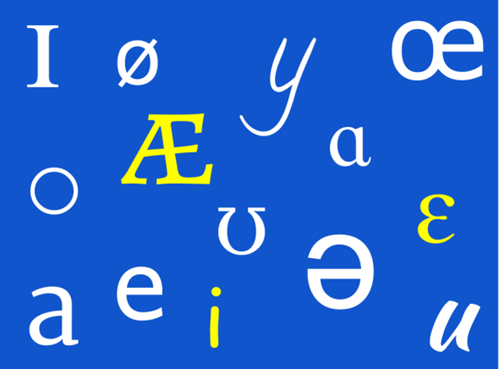
How many English vowels are there?
Why are vowels so difficult?
Vowels can be frustrating for English learners, and for good reason! Vowels are much more abstract than consonants. You can describe a consonant by its place, manner, and voicing, and those are very concrete terms (think: both lips, stopping of air, voice on for the “b” sound). However, vowels exist along a continuum of an open mouth and throat that you change to be either more open or less open to make the different vowel sounds (that is the abstract part!).
Another reason why vowels can be so frustrating for non-native English speakers is because you can’t rely on the spelling of the word to tell you how to pronounce that vowel. This is also somewhat true for consonants, but it’s even more true for vowels.
Let’s take the example of the words woman and women. Both are spelled with the vowel letter “o”, but that letter is pronounced differently in each word:
Woman: /wʊmən/
Women: /wɪmɪn/ or /wɪmən/
Or the words bead and head. Both words contain the “ea” vowels spelling, but they are pronounced differently:
Bead: /bid/
Head: /hɛd/
These examples highlight a very important part of spoken English: English is not a phonetic language. The spelling of a word does not always match up with how it is pronounced. So to be the most successful with English pronunciation, you need to develop a strong awareness of the sounds that you hear rather than the spelling of the words.
The American English Vowel Quadrilateral
Imagine the inside of your mouth - what does it contain? Towards the front are your lips and teeth, on the bottom is your tongue, on the top is the roof of your mouth, and in the back is a hole that leads to your throat. Now open your mouth, and notice what happens to the space inside your mouth. This space opens up as your jaw drops down, and as your jaw drops down, your tongue goes down with it.
It is helpful to think of this space when you say a vowel sound because this is the space where vowels are made. Remember, vowels are made by changing the shape of your mouth and throat, and you do this by moving your jaw and tongue. We think of this space as the shape of a quadrilateral.
The left of the quadrilateral represents the front of your mouth, and the right of the quadrilateral represents the back of your mouth. The open space within the quadrilateral itself represents the open space in your mouth.
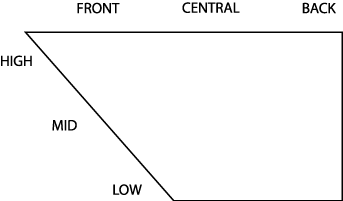
Let’s look at this quadrilateral again, but with a different perspective. This second drawing depicts the side of a person’s face, and the mouth is open. The quadrilateral has been placed inside the person’s open mouth.
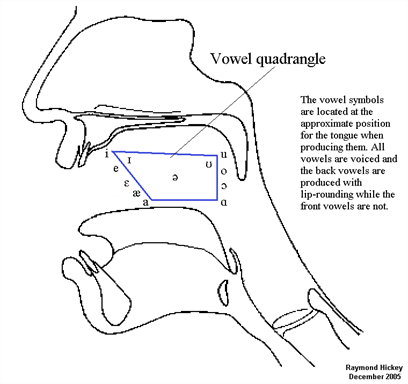
The Corner and Central English Vowels
At each corner of the quadrilateral are what we call the corner vowels: /i/, /æ/, /u/, and /ɑ/. These represent the boundaries of the American English vowel set. The /i/ vowel (like in the word she) is considered a high, front vowel, meaning it is made with the tongue positioned high and in the front of the mouth. As you progress down the quadrilateral, your jaw drops down (bringing your tongue down with it), and this leads you to the low, front vowel /æ/ (like in the word cat). The vowel at the top right corner is the /u/ vowel (like in the word boot), which is a high, back vowel (tongue high and back in the mouth). Your jaw drops down again as you move down the quadrilateral to end on the /ɑ/ vowel (like in the word hot), a low, back vowel.
In the center of the quadrilateral are the vowels /ʌ,ə/ (the “uh” sound, like in the word cup) and /ɝ,ɚ/ (the “er” sound, like in the word bird). These vowels are made with a more neutral tongue position - the tongue is somewhere in the middle of the mouth.
American English Vowel IPA Chart — Monophthongs
Now that you have a basic understanding of what the quadrilateral represents, I’ll include it here again with all of the vowel IPA symbols for the American English monophthongs:

American English Monophthongs

American English Vowel IPA Chart — Diphthongs
So far, the types of vowels I’ve been discussing are called monophthongs, meaning the vowel is comprised of just one sound (mono = one). However, the American English vowel system also contains diphthongs, which are one sound created by the combination of two vowels (di = two). When you say a diphthong, you should feel movement in your jaw and tongue as you progress through that sound.
For example, the vowel /e͡ɪ/ (like in the word late) is a diphthong vowel. It starts with the /e/ vowel and moves towards the /ɪ/ vowel, and as you say /e͡ɪ/, you should feel that your jaw is open at the beginning, then closes slightly for the last part of the sound.
Here is a vowel quadrilateral that shows the American English diphthongs:
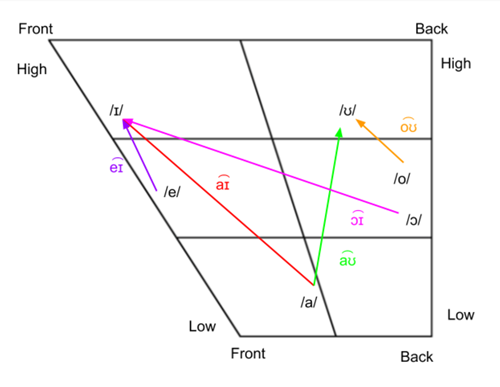
American English Diphthongs
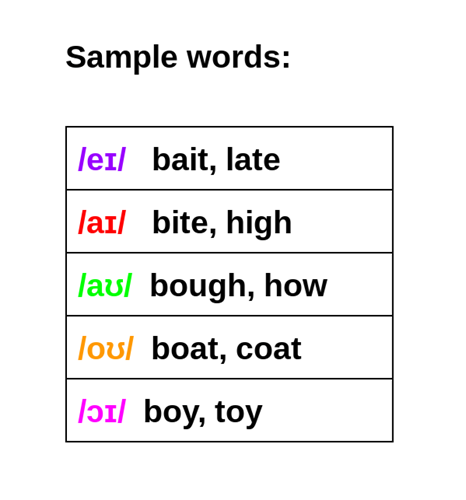
American English Diphthongs
Additional Practice
Here are practice words to help you with the American English vowels (and click here for a FREE printout of the IPA chart for monophthongs):
Monophthongs:
/i/ beet
/ɪ/ bit
/ɛ/ bet
/æ/ bat
/u/ boot
/ʊ/ book
/ɔ/ caught*
/ɑ/ cot*
/ʌ/ but
/ə/ about
/ɝ/ Burt
/ɚ/ after
*Note: Some dialects of American English pronounce caught and cot with the same vowel /ɑ/. I do this - I use the same vowel /ɑ/ in both of those words, and I was born and raised in California.
Diphthongs:
/e͡ɪ/ bait
/a͡ɪ/ bite
/o͡ʊ/ boat
/ɔ͡ɪ/ boy
/a͡ʊ/ bout
Thanks for watching! And I'd love to hear from you - contact me to learn how we can work together to perfect your American English pronunciation!
******************************************************************************************************
Interested in more American English pronunciation practice? Be sure to check out some of my most popular online resources (all free!):
- Dark L and Light L exercises: Free, downloadable and printable pdf
- Semi-Occluded Vocal Tract (SOVT) exercises: Free, downloadable and printable pdf
- Stressed and Unstressed Syllables exercises: Free, downloadable and printable pdf
- AH /ɑ/ and UH /ʌ/ Vowel pronunciation exercises: Free, downloadable and printable pdf
- American R /ɹ/ Consonant pronunciation exercises: Free, downloadable and printable pdf
- Vowel to Vowel Linking exercises: Free, downloadable and printable pdf
- Consonant to Vowel Linking exercises: Free, downloadable and printable pdf
- Word Reductions and English Rhythm exercises: Free, downloadable and printable pdf
- N /n/ and NG /ŋ/ Consonant pronunciation exercises: Free, downloadable and printable pdf
- Respiratory and Breath Support exercises: Free, downloadable and printable pdf
- International Phonetic Alphabet (IPA) for English Vowels: Free, downloadable and printable pdf
- International Phonetic Alphabet (IPA) for English Consonants: Free, downloadable and printable pdf
- Resonatory and Vocal Projection exercises: Free, downloadable and printable pdf
- Articulatory and Tongue Twister exercises: Free, downloadable and printable pdf
- Glottal Stop T /ʔ/, Flap T /ɾ/, and True T /t/ exercises: Free, downloadable and printable pdf
- EE /i/ and IH /ɪ/ Vowel pronunciation exercises: Free, downloadable and printable pdf
- Presentation Skills Training exercises: Free, downloadable and printable pdf
- Sentence-level Stress and Content Word Stress exercises: Free, downloadable and printable pdf



